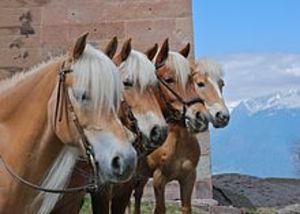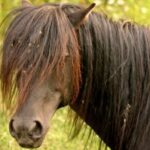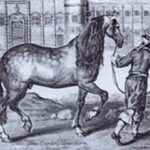Haflingers, also known as the Avelignese, may be small like ponies, but they are referred to as horses by those who are fanatical about them. They are incredibly strong for their small size. Their strength, pleasant attitude, versatility and chestnut coats have given them admirers all throughout Europe and North America.
There are two types of Haflingers bred now – a slimmer riding type and a heavier draft type for harness. Both types are strong, friendly and intelligent.
General Appearance
Haflingers are always chestnut, although they can range from an almost chocolate dark chestnut to a pale gold. They often have contrasting flaxen or white manes and tales. They often have white on their legs and faces and usually have dark colored lips. The color on their legs often fades in much the same way the color on a Belgian draft horse’s leg color fades.
Haflingers have thick legs, sturdy bodies and good hooves. Their backs are usually level and short, with muscular hindquarters and shoulders. Their heads used to be very thick and pony-like, but that is now gone and they have very slim, horse-like heads with large nostrils and kind eyes. Sometimes their ear tips will point towards each other like an Arab’s.
They average thirteen to fourteen hands, but reaching to fifteen hands is not uncommon. Even a thirteen hand Haflinger is strong enough to carry an adult rider or pull a plow. One of the breed’s nicknames is “the tractor of the Alps” and they still are used so to this day in some parts of the Alps.
It is thought that Haflingers are incredibly inbred, since their color is so fixed. However, they do not show the health defects common in closely inbred animals. Also, Haflingers are generally long-lived, often reaching 40.
Brief History
Haflingers originated in the Austria Alps that dips down into Italy, descendants of a local breed known as the Tyrol. According to Judith Dutson in Storey’s Illustrated Guide to 96 Horse Breeds of North America, Tyrols were thought to have been around as early as 555 CE. The Tyrol was probably not too different from the Haflinger – only a bit chunkier. The Tyrols were eventually crossed with Arabian stallions as early as 1868.
Folie, a son of a Tyrolean mare and a half-Arabian stallion, was foaled in 1874. He was a striking chestnut with a light mane and tail. He became the foundation sire of the Haflinger breed.
All breeds of horses suffered during and just after World War II – with the possible exception of the Haflinger. They were used to hard work. After the fall of Hitler, the Austrian government took charge of the breed. They were first exported to America in 1960 and are becoming more popular for harness work and recreational riding.
Additional References
International Encyclopedia of Horse Breeds. Bonnie Hendricks. University of Oklahoma Press; 1995.
The Encyclopedia of Horses & Ponies. Tasmin Pickeral. Paragon Publishing; 1999.
Storey’s Illustrated Guide to 96 Horse Breeds of North America. Judith Dutson. Storey Publishing; 2005.
The Official Horse Breeds Standard Book. Fran Lynghaug. Voyageur; 2009.







